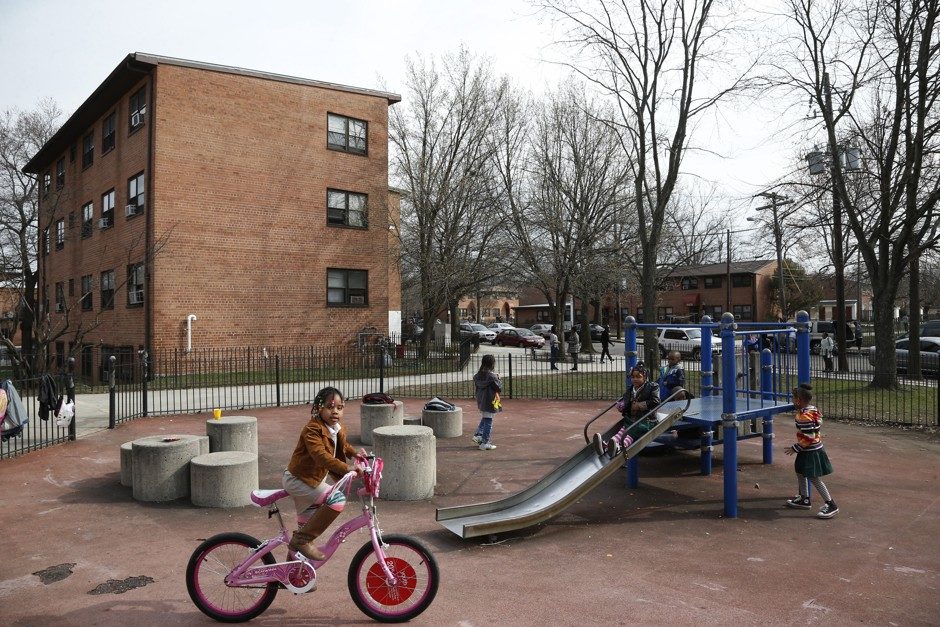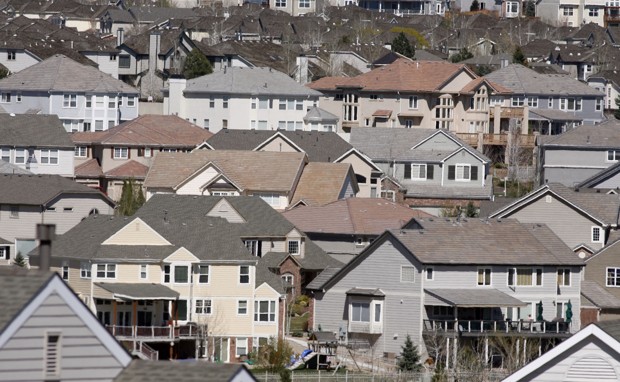Economically Diverse Neighborhoods Give Poor Black and Latino Youth a Leg Up

This photo taken April 2, 2014 shows children playing in the Kenilworth-Parkside neighborhood of Washington. Backed by a multi-year, $28 million Education Department grant, the DC Promise Neighborhood Initiative (DCPNI) vows to tackle generational poverty with a fresh approach -- if a parent’s level of education improves, so does a child’s prospects. In Kenilworth-Parkside, helping the children get a good education is a primary focus, but it’s the adults they must first engage. And many of them are skeptical. (AP Photo/Charles Dharapak)
By Mimi Kirk
George Galster, a professor of urban affairs at Wayne State University, and his co-authors chose the Denver program because it assigns low-income families to a variety of neighborhoods. “Most jurisdictions put public housing in large-scale apartment buildings in disadvantaged neighborhoods,” says Galster. “Denver has some of that, but it’s more likely that families will be assigned to other areas, from wealthy suburbs to everything in between.”
This meant that Galster and his colleagues could get a sense of how different environments affect young residents. They looked at such neighborhood elements as income level, employment rate, and prevalence of crime, and conducted extensive interviews with program recipients. That the Denver program randomly assigns families also makes it ideal for study; with self-selection removed from the equation, the results of the research are based on place rather than individual choice.

While the findings show variations in benefits for black versus Latino youth, Galster makes the claim that these young people on the whole gain from living in economically diverse neighborhoods. “It’s clear that low-income Latino and African-American kids do better on a variety of outcomes when they have folks of a higher occupational status surrounding them,” he says.
Galster’s findings also demonstrate that class desegregation has more power than racial desegregation to improve the lives of black and Latino kids. “That’s not to say that racial segregation isn’t important,” he says. “The racial dynamic also works to create inferior environments. But concentrations of deprivation among any race is the major enemy.”
Galster’s research is of particular significance because it diverges from many “Moving to Opportunity” studies. These are based on data from the 1994 government program of the same name, which gave families living in some of the most high-poverty public housing projects in Baltimore, Boston, Chicago, Los Angeles, and New York vouchers to move to lower-poverty areas for a year.
Much of this research found little correlation between the move and outcomes for youth in terms of education and, later, employment. (However, more recent studies show positive long-term educational and employment outcomes for children who moved to a low-poverty neighborhood before the age of 13.)
Galster’s studies also have implications for housing policy. He says, for instance, that the Section 8 voucher program, which provides low-income families with coupons to secure better rentals in areas of their choosing, doesn’t give these families enough motivation to move to low-poverty areas.
Galster adds that the Low Income Housing Tax Credit, a tool used by the federal government to build affordable housing across the country, often targets poorer neighborhoods (despite the fact that the Supreme Court ruled in 2015 that the credit cannot only be used in low-income or majority-minority communities). “Affordable housing is targeted to poor neighborhoods in the mistaken belief that these areas have the greatest need,” says Galster. “Yes, but do you want to lock people into that geography? I say no. We need to change the targeting.”
Yet these potential policy changes, however rooted in research and compellingly argued, face an uphill battle to gain inroads with the new administration and Congress. My colleague Kriston Capps reported in January, for instance, that likely reductions in corporate tax rates have already caused investors to limit their investment in the Low Income Housing Tax Credit, meaning that fewer desperately needed affordable units will be built. In such straitened circumstances, efforts to tweak the targeting of the credit would likely take a backseat to simply working to sustain it.
Capps also recently reported that preliminary budget documents indicate that the Trump administration may cut HUD’s budget drastically, by $6 billion, or 14 percent from current funding levels. While this is an opportunity for HUD Secretary Ben Carson to fight for the department and for the programs that help poor families keep a roof over their heads, Carson’s views on housing inequality don’t make him a promising advocate.
“Carson is not a believer in the geography of opportunity; rather, he subscribes to the idea that everyone can raise themselves up by their bootstraps with hard work, regardless of where they live,” says Galster. “He’s not going to be terribly sympathetic to the kinds of ideas found in my research.”